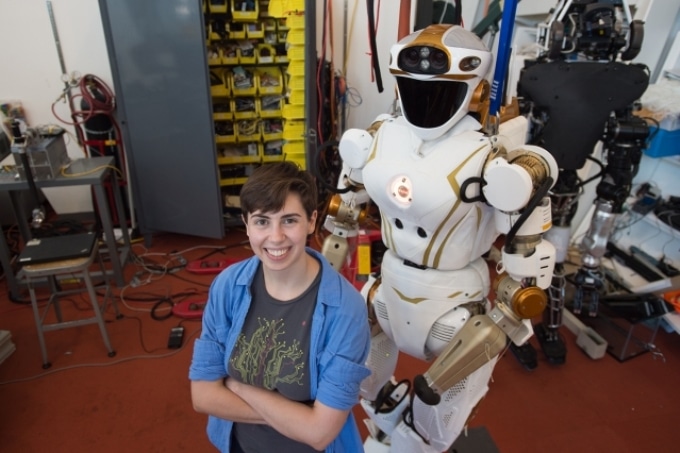Oct 19 2016
 “One thing you realize working in this lab is that we are really far away from the robot apocalypse,” says MIT senior Sarah Hensley, who is working with a team of researchers to prepare Valkyrie, a humanoid robot, for future space missions. “Sometimes robots work, and sometimes they don’t. That’s our challenge.” (Photo: Gretchen Ertl)
“One thing you realize working in this lab is that we are really far away from the robot apocalypse,” says MIT senior Sarah Hensley, who is working with a team of researchers to prepare Valkyrie, a humanoid robot, for future space missions. “Sometimes robots work, and sometimes they don’t. That’s our challenge.” (Photo: Gretchen Ertl)
A six-foot, 300 pounds weighing astronaut named Valkyrie is being prepared by Sarah Hensley for a mission to Mars. It is equipped with an extended chest cavity making it look distinctly female. Hensley is working on the movements of one of Valkyrie's arms throughout the current semester.
Hensley is a fourth-year electrical engineering student at MIT, and is collaborating with a group of researchers to prepare Valkyrie, a humanoid robot also referred as R5, for future space missions. Hensley spent her spare time reading Asimov’s classic robot series during her teen years.
I’m a huge science fiction nerd - and now I’m actually getting to work with a robot that’s real and not just in books. That’s like, wow.
Sarah Hensley, Student, MIT
As one of only three undergraduate students in the Robot Locomotion Group in MIT's Computer Science and Artificial Intelligence Laboratory, Hensley is analyzing Valkyrie for an advanced independent research program, or SuperUROP. Several of her colleagues are postdocs or graduate-level researchers with great deal of expertise in complex humanoids.
Professor of electrical engineering and computer science Russ Tedrake heads this group. Tedrake had successfully programmed Valkyrie’s predecessor Atlas to open doors, drill holes, turn valves, drive a car and climb stairs for the DARPA Robotics Challenge in 2015.
Valkyrie has four body cameras, 28 torque-controlled joints, and over 200 individual sensors, Hensley says. The robot can bend its joints, walk, and turn a door handle. “This is one of the most advanced robots in the world. And it’s 20 feet from my desk,” she adds.
MIT along with Northeastern University and the University of Edinburgh have been chosen by NASA to develop software facilitating the robot to perform space-related tasks such as opening airlock hatches, repairing equipment, attaching and removing power cables, and retrieving samples. Also, be able to get back on its feet if it falls down.
Hensley joined the lab over the summer, and is curious about the challenge of harmonizing the movements of a very complex system. “I am trying to solve a very tricky problem,” she says. She is exploring the best way to control the elbow movements of Valkyrie by comparing two potential techniques.
One uses a key controller to collect data from several motor systems within the arm, and then uses that data to formulate accurate movement decisions. The other technique is decentralized, and leaves it to each motor system to make a decision and perform on its own.
Is it better to have multiple decision makers with access to different information? Or is better to have one decision maker choosing all of the motor inputs?
Sarah Hensley, Student, MIT
She has already been accepted into a master’s degree program in electrical engineering at MIT. She hopes to pursue her work on Valkyrie.
On a daily basis, Hensley walks across the Massachusetts Avenue Bridge to the Stata Center from her co-ed fraternity house (Tau Epsilon Phi) in the Back Bay; and sits before two large monitors in the robotics lab. She examines numerous scientific literatures and writes code for computer simulations of the equations that move the arm of the robot.
When Valkyrie is turned on and moves, Hensley says, it often “kind of shivers and falls down. One thing you realize working in this lab is that we are really far away from the robot apocalypse,” she quips. “Sometimes robots work, and sometimes they don’t. That’s our challenge.”